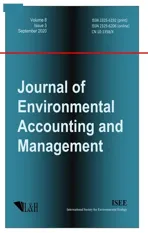The Prevalence of Students and Teachers’Ideas about Global Warming and the Use of Renewable Energy Technology
2020-06-22LukmanAbdulRaufLaliyoFentyPuluhulawaSunartyErakuYuszdaSalimi
Lukman Abdul Rauf Laliyo,Fenty U.Puluhulawa,Sunarty Eraku,Yuszda K.Salimi
1 Department of Chemistry,Universitas Negeri Gorontalo,Indonesia
2 Department of Law,Universitas Negeri Gorontalo,Indonesia
3 Department of Geography,Universitas Negeri Gorontalo,Indonesia
Keywords Prevalence Global warming Renewable energy
Abstract This study aims to explore the prevalence of students’and teachers’ideas about global warming and the use of renewable energy technology in Gorontalo, Indonesia. Employing a non-experimental quantitative approach,the data were collected from 1522 respondents and analyzed with the WINSTEPS 3.73 Rasch software. This study reports that 97.6% and 76.08%of the respondents respectively understand the concepts of global warming and renewable energy from the internet(45%)and formal education (<40%). Respondents’ level/status of education, gender, and hometown cause some differences in their ideas prevalence. High school students consider that utilizing renewable energy is not crucial; they also do not concern about global warming effects and the environment. Teachers and university students do not believe that using renewable energy can produce sustainable energy;they also question the safety of renewable energy technology.These findings indicate the needs for a renewable energy literacy program in formal education in Indonesia.
1 Introduction
The increase in global warming, largely due to the greenhouse effect, has begun to be considered as a real phenomenon over the past two decades (Kilinc¸ et al., 2009). In line with this issue, people are also more aware of the effects of global warming on the global, social, and economic environment (Guven and Sulun,2017). According to The Intergovernmental Panel on Climate Change, 2018, the latest information reported by the most authoritative source explains that some negative consequences of global warming have occurred;although the increase in greenhouse gas emissions in the atmosphere can be stabilized, these consequences are still difficult to avoid until today. A special report states that the effects of global warming have led to an increase in the earth’s surface temperature by around 1.5◦C.According to G¨uney,2019;Kilinc¸ et al.,2009;Ntona et al.,2015. several political leaders in the developed countries, although they have different perspectives on certain cases,have admitted the truth and the urgent needs to reduce greenhouse gas emissions on a world scale.
According to Guven and Sulun,2017,most developed countries prefer to use energy from fossil fuel,such as petroleum and coal. In addition to the low price,the technology utilized to produce such energy has significantly improved in the last two centuries. According to Panwar et al.,2011, nevertheless, the utilization of this fossil fuel has contributed to the increase in greenhouse gas concentrations, e.g., CO2, CH4, CFCs, halon, N2O,ozone, peroxyacetyl nitrate in the atmosphere which tends to be more alarming. Consequently, the earth’s surface temperature has increased and caused negative effects on human health and environment,particularly air pollution,acid rain,global warming,and climate change.
According to Panwar et al., 2011; Worrell et al., 2009, one of the largest contributions to the increasing CO2in the atmosphere is human activities,e.g.,using conventional fuel for vehicle and electrical energy generation. Various studies reveal that CO2in the atmosphere has gone up to approximately 31 percent in 200 years;meanwhile, global gas emissions have increased by around 37 percent. Moreover, the world temperature has increased by averagely 0.7oC.
According to Acikgoz, 2011, the issues arisen from the effects of global warming along with the world oil crisis in 1973 have motivated the developed countries to resolve it by developing two main strategies,including 1). Reducing greenhouse gas emissions produced by the utilization of fossil energy;2). Developing technology to produce energy from non-carbon alternative sources,this attempt is intended to produce energy from renewable and sustainable sources as well as being able to minimize waste,to decrease air pollution and greenhouse gas emissions,and protect forest and nature.
According to Guardiola et al.,2009, the production of renewable energy, that can be sourced from the sun,wind,geothermal and hydraulic energy as clean energy sources,does not produce toxic greenhouse gas and not pollute the environment;it will always be used and renew itself naturally. The developed countries have carried out the implementation of both strategies to decrease the effects of global warming. However, the developing countries,Indonesia,for instance,tend to face a big challenge,emerging from the investment,technology readiness,and community support in particular. This present study focuses on exploring the community support and participation, especially in terms of technology utilization driven by renewable energy sources.
As reported in some print media,Indonesia is the fourth largest population in the world,with an estimated population of 252 million;they are assumed to use fossil energy at 893 Mboe(barrel of oil equivalent)(Nugroho et al., 2017). According to Tondang, 2019a, in the Southeast Asia region, on the other hand, Indonesia is one of the countries with the largest energy consumers (Tondang, 2019a) and is trying to optimize the use of abundantly-available renewable energy resources(Adzikri et al.,2014). According to the World Bank 2019,the level of power use in Indonesia is around 812 kWh per capita. This number is higher than India and is predicted to continue to increase every year.
According to Tondang,2019b,Indonesia geographically has the potentials for developing renewable energy.It is able to generate 716 GW of energy from solar photovoltaic(solar PV),hydropower,bioenergy,geothermal,ocean wave power, and wind. Nonetheless, Indonesia still needs to encounter a big challenge, specifically the limited open field for energy utilization from solar PV,high investment cost for new and renewable technology use, and little support and participation from the community. According to Kilinc¸ et al., 2009; Wolsink, 2007,Community support and participation play an important role in the transition of the use of renewable energy technology. Regarding this, a study in Europe figures out that society provides good support for the further implementation of developing renewable energy technology. Indonesia,in contrast,finds it challenging to obtain scientific information related to community acceptance and support about the utilization of renewable energy.According to Daniel et al.,2004,for this reason,a study on the extent to which students and teachers contribute to reducing global warming and their behavior towards the use of renewable energy should have been conducted.
According to Zarnikau,2003,several previous studies focus on the level of community acceptance and support towards the renewable energy utilization, e.g., people’s needs for “green energy” and energy efficiency,perception and behavior on the development of renewable energy (Johansson and Laike,2007), environmental concern and consumers’ trust on renewable energy (Bang and Ellinger, 2000), energy conservation and awareness of renewable energy(Assali et al.,2019),renewable energy and its sustainable development(G¨uney,2019).Besides, a study related to students’ and teachers’ knowledge include the prospective teachers’ knowledge and awareness of renewable energy(Guven and Sulun,2017),students’trust on the benefits of nuclear and renewable energy (Skamp et al., 2019), students’ ideas and viewpoint on renewable energy (Kılınc¸ et al., 2008; Komendantova et al., 2018), students’ knowledge, perception, and behavior towards renewable energy (Ntona et al.,2015; Zyadin, Puhakka et al., 2012), renewable energy education (Acikgoz, 2011). Furthermore, by adopting the method from the conducted study, the purpose of this present study is to explore the prevalence of ideas of students and teachers in Indonesia, as the consumer generation, educator, and decision-maker in the future towards the use of renewable energy.
Prevalence refers to the general viewpoint(Badan Pembinaan dan Pengembangan Bahasa,2016). The prevalence of the idea of utilizing renewable energy can be defined as a general idea that is commonly understood,related to the use of renewable energy. Ideas are constructively formed by individuals who always learn. According to T Rahayu,2017,heir learning process of experience will determine the quality of the idea construction. If the idea construction of renewable energy use is obtained directly from the formal learning experience,students’and teachers’ ideas will be more meaningful. It implies that they can understand well the characteristics of the utilization of renewable energy and to show holistic and interrelated viewpoint between technology and the use of renewable energy as well as the reduction of the bad effects of global warming on the environment. By exploring this idea, the readiness of students and teachers can be evaluated as an effort to explain the extent to which the level of acceptance and sustainability of the adoption of renewable energy technology will be achieved in the future. If the ideas tendency contradicts each other, it will raise a presumption that students and teachers understand the concept of renewable energy utilization and global warming in a partial way, not in a holistic way. This can also elaborate on the reason for students’and teachers’low concern on the environment.
This study is a significant part to“read”(learn about)the prevalence of ideas of renewable energy use among students and teachers as formal educators. The urgency is based on the needs to evaluate the readiness level of knowledge and comprehension of renewable energy and its utilization as a consumer, educator, and energy decision-maker in the future. The significance is that since formal education is a strategic medium to grow concern about and adoption of renewable energy technology, then the prevalence of ideas among students and teachers should have represented a positive tendency for the use of renewable energy.
According to Assali et al., 2019, the failure of applying renewable energy in any country is due to the low awareness of the community, unsuccessful policy, and market characteristics. The lack of community acceptance and willingness to utilize renewable energy can serve as the main barrier for renewable energy diffusion. According to Schubert and Forbes, 2019, hence, it is crucial for the community in general, students and teachers in particular, to expand their basic understanding of the concept of energy and the ability to make a decision based on the information about the issues of renewable energy utilization. This is what the world of education and learning in schools are responsible for. According to Martin and Jucker, 2005, education plays a vital role in raising awareness of environment, skill, and behavior (The United Nations Conference on Environment and Development, 1992); University, in particular, contributes significantly to educating “future leaders”.
According to Kandpal and Broman,2014,a topic about energy has been learned in primary and high schools,even been introduced since children reach the age of 5. A small part of this present study studies the insight of the high schools’ students; it reveals that they generally have limited knowledge of the main concept of energy(Bodzin,2012;DeWaters and Powers,2011;Rose and Barton,2012). More than half of the students can define renewable energy accurately,and only 36.1%of the total students at grade VIII who can correctly identify natural gas as the renewable energy source. Moreover,less than half of the students can identify coal as abundant fossil fuel in the United States. According to Bodzin, 2012; DeWaters and Powers, 2011, a study reported by Rose and Barton (2012) concludes that high school students tend to present a complex thought and consider various perspectives if they are asked to state their decision about the use of power generation technology. They ultimately choose to agree with the social benefits of utilizing energy with a lower cost,compared to the effects of reducing carbon emissions drastically. In the context of education in Indonesia, it encounters a differentreality;this encourages the idea of conducting this study in order to answer two questions,including
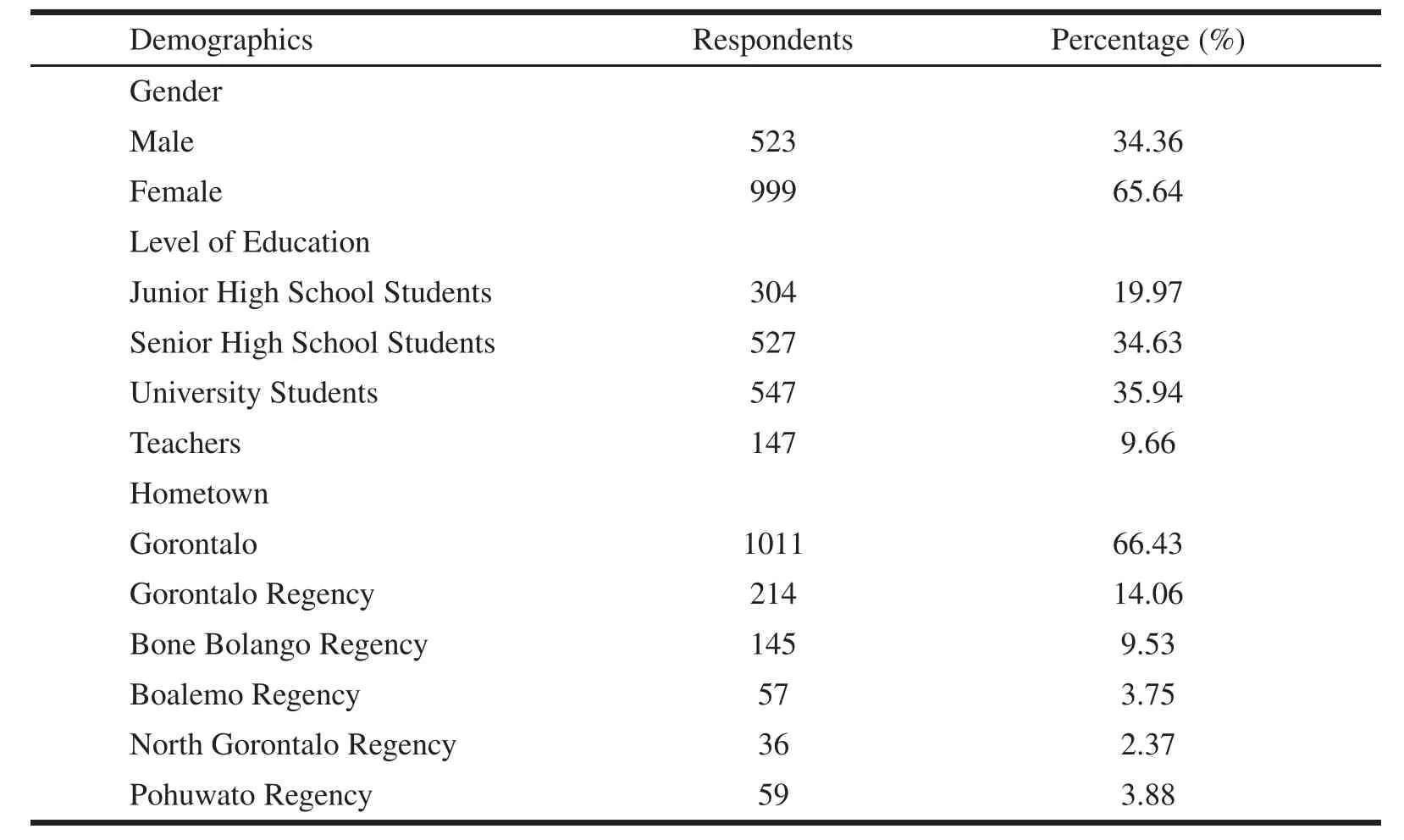
Table 1 Demographic profile of respondents(N=1522).
a)how is the prevalence of students’and teachers’ideas about the use of renewable energy?
b)are there any significant differences in the prevalence of students’and teachers’ideas about the utilization of renewable energy based on their demographic differences(level of education,gender,and hometown)?
2 Method of study
2.1 Respondents
Employing a quantitative survey approach,this study used the prevalence of students’and teachers’ideas about the use of renewable energy as the variable measured by a questionnaire. It was conducted in March 2019 and applied the convenience sampling in selecting the sample; the respondents were directly given a questionnaire. Concerning ethical considerations, respondents’ consent to participate in this present study was firstly asked before filling out the questionnaire. Participation was very voluntary and used anonymity. Respondents’demographic profile is presented in Table 1.
2.2 Instrument
A questionnaire with closed-ended questions was developed to measure the prevalence of respondents’(students and teachers) ideas about the utilization of renewable energy. In this present study,the prevalence of ideas was measured based on the aspects of knowledge,viewpoint,and behavior of the respondents about the concepts of global warming,the types of renewable energy resources,the characteristics of renewable energy,the advantages and disadvantages of using the technology of renewable energy. The majority of the questionnaire contents(see Appendix A)was adapted from the instrument used by Kilinc¸et al. (2009);Yang,Tsou,Chen,Chan,and Chang(2011).
In the first section, the respondents were asked to fill out demographic questions, i.e.,name,status/level of education,and hometown. Further,they were requested to answer four groups of items,including 1)a group of item functioned to identify the respondents’knowledge of the concepts of global warming,renewable energy,the types of renewable energy resources, renewable energy products, and the sources of the respondents recognizethe term global warming and renewable energy at the first time;this group was started from item 1 to item 7;2)a group of item intended to measure the respondents’ knowledge of the characteristics of renewable energy as well as the advantages and disadvantages of using power generation technology from renewable energy sources;this group was started from item 8 to item 21. Respondents’ responses had been provided, and they needed to select one of five options; strongly disagree (SD),disagree (D),neutral (N),agree (A),or strongly agree(SA);3)a group of item used to measure students’ viewpoint related to the importance of utilizing renewable energy technology. Viewpoint,in this context,reflects respondents’opinion(behavior)regarding renewable energy;this group was started from item 22 to item 29. Respondents chose one of four options provided; very unimportant(VU),unimportant(U),important(I),very important(VI).

Table 2 Reliability of person and item.
Unlike the previous three groups of items, the fourth group of items measured the level of respondents’awareness of global warming effects on the environment; this group was started from item 30 to 33. The characteristics of each item were different from one another,initiated by the question of the extent to which they concerned about the effects of global warming on the environment. Four options provided to the respondents included really unconcerned(RU),a bit concerned(BC),concerned(C),and really concerned(RC).In addition,respondents’ responses to how well they know about the effects of global warming were asked. Respondents selected one of four options of very unknowledgeable (VU), a bit knowledgeable (BK), knowledgeable (K),very knowledgeable (VK).The next question was about whether or not they always protect the environment, in which the provided responses consisted of not at all(NAA),once in a while(OW),sometimes(S),always(A).Lastly, the respondents were asked about their opinion about whether or not global warming recently occurs;the provided responses were I believe that global warming does not occur (IBGWDNO), I think that global warming does not occur (ITGWDNO), I do not know that global warming occurs (IDNKGWO), I think that global warming occurs(ITGWO),I believe that global warming occurs(IBGWO).
After the actual data were collected, respondents’ responses were divided into two data groups. The first group (responses for item 1-7) was analyzed employing the descriptive percentage method; the second group(responses for item 8-33)was tabulated into the Microsoft Excel format,and was analyzed using the WINSTEPS 3.73 version software as the Rasch measurement model. According to Linacre, 2012; Bond&Fox,2015), the validity and reliability of the instrument were obtained through the calibration of the levels of item difficulty and respondents’ ability. WINSTEPS software mathematically transformed raw ordinal data (Likert-typed data),based on the response frequency that came up as a probability,to logit(log-odds)through logarithmic functions that assessed the suitability of the whole instrument and the respondents.
The reliability value of the internal instrument is shown in Table 2 that was processed based on the data(see Appendix B).This value referred to the result of “summary of fit statistics” or reliability index in the form of logit measure,as the determinant of questionnaire quality and instrument psychometrics.
2.3 Unidimensionality and rating scale analysis
Table 2 indicates that the Person Reliability Index(0.74)empirically showed pretty good consistency in respondents’ responses (Sumintono and Widhiarso, 2014), implying that the scale was able to discriminate respondents’ responses very well. It also applied to the Item Reliability Measure (1.00) that was categorized “very good”(Sumintono and Widhiarso,2015),meaning that the respondents’had a very high probability in responding to the questionnaire items. The estimation of the high value of the item reliability signified that the item greatly defined the latent variables (Bond and Fox,2015). According to this measurement result of the Person and Item Reliability,the questionnaire was reliable to be used in various groups of respondents.
2.4 Cronbach alpha
The coefficient value of Cronbach Alpha KR-20 (0.77) described a good interaction among 1522 respondents with 26 items(Sumintono and Widhiarso,2015). It implied that the instrument was reliable for having excellent consistency in internal psychometrics.
2.5 Person and item separation index
Respondents separation index (Person Separation Index) is an estimated value functioned to discriminate respondents’ ability, or in this case, is the latent characteristics (of the measured item). The higher the Person Separation Index, the higher the respondents’ probability in responding to those items accurately. Person Separation Index also indicated the item’s distribution, from the easiest to the most difficult items (Boone et al.,2014); the broader the distribution, the better the items. Based on Table 2, the Person Separation Index (1.70)and Item Separation Index(19.75)showed fairly good distribution of questionnaire items to various respondents and items. The results of this criteria measurement asserted that the used questionnaire was reliable and suitable to measure the prevalence of respondents’ideas in understanding the utilization of renewable energy.
2.6 Data analysis
Respondents’ data analysis in the first group of item (item 1-7) employed descriptive statistics and average value. On the contrary, respondents’ data analysis in the second, third, and fourth groups (item 8-33) used the WINSTEP 3.73 version software as the Rasch measurement model.The average value in the Rasch measurement model was in the form of a logit scale that had been converted from the score of the Likert scale. The higher the logit value of the item,the higher the difficulty of the item;meaning that the item would be complicated for the respondents to work on. The Differential Item Functioning was intended to identify respondents’ responses based on their demographic profile (gender, level of education, and hometown). This analysis would inform the acceptable items according to respondents’ demographic characteristics. Thus, this analysis was the most suitable method to explain empirical facts as in line with the purpose of this study.
3 Results
3.1 Knowledge of global warming and renewable energy
Figure 1 displays the graphics of respondents’ responses over the questions “do you know the term global warming?” (item 1), “where did the first time you know about global warming?” (item 2), “do you know the term renewable energy?” (item 3),“where did the first time you know about renewable energy?” (item 4).
Almost all respondents (97.6%) recognize the term global warming and only three-quarters of the total respondents (76.08%) who know the term renewable energy. They get those terms mostly from the internet(45%); less than 40% of the respondents know both terms from formal education, i.e., Junior High School,Senior High School,and University. Additionally,Figure 2 presents the graphics of respondents’responses over the definition of renewable energy(item 5),renewable energy sources(item 6),and renewable energy technology(item 7).

Fig.1 Respondents’knowledge of global warming and renewable energy. Ya=Yes, Tidak=No, A=Friend,B= Family,C=Print Media,D=Internet,E=Elementary School,F=Junior High School,G=Senior High School,H=University,I=Others.
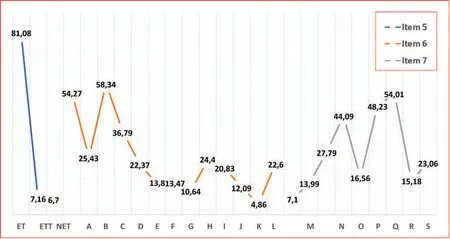
Fig.2 Respondents’responses over the definition of renewable energy(item 5),renewable energy sources(item 6),and renewable energy technology(item 7). ET=renewable energy,ETT=non-renewable energy,NET=Others,A=wind,B=waves,C=sun,D=river,E=underground water,F=biological waste,G=ocean and sea,H=hydrogen,I=petroleum,J=coal,K=fuel,L=radioactive,M=natural gas;N=energy sources power generation(PLSE),Hydrogen,O=PLSE biomass,P= PLSE waves, Q= PLSE wind, R= PLSE thermal, S= PLSE water, T= PLSE sun, U= PLSE nuclear, and V= PLSE geothermal.
More than three-quarters of the respondents (81.08%) opine that renewable energy is energy that can be regenerated or renewable as its term; a small number of respondents (13.86%) cannot define renewable energy. The most widely known sources of renewable energy are sun (58.34%), wind (54.27%), river (36.79%),waves(25.43%),natural gas(22.60%),underground water(22.27%),biological waste(13.80%),ocean and sea(13.47%),Hydrogen(10.54%),and radioactive(4.86%). Nevertheless,some respondents still choose petroleum(24.44%),coal(20.83%),and fuel(12.09%)as renewable energy sources,implying that they do not understand the concept of renewable energy. Regarding the types of power generation from renewable energy sources,more than ten respondents mention sun(54.01%),water(48.23%),wind(44.09%),waves(27.79%),geothermal energy(23.06%),natural gas(22.60%),nuclear(15.18%),biomass(13.99%),and Hydrogen(7.10%).
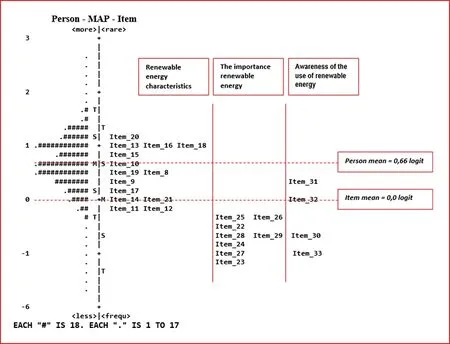
Fig.3 Wright Map,Person-Map-Item.
3.2 Students’and teachers’ideas about the characteristics of renewable energy
The second section of the questionnaire explored respondents’ ideas about the characteristics of using the technology of renewable energy. The analysis encompassed two things;1)item analysis used to identify respondents’ideas about the advantages of utilizing the technology of renewable energy (item 8, 9, 12, 14, 17, and 21); 2)item analysis functioned to identify respondents’ knowledge of the disadvantages of using the technology of renewable energy (item 10, 11, 13, 15, 16, 18, 19, and 20). Their responses in the form of ordinal data were converted to interval data by applying the Rasch model. The results are shown in Figure 3 in the form of Wright Map (Person-Map-Item). This map presents distribution layouts of the respondents’ consent level (on the left side) and the difficulty level of the item consent (on the right side). The distribution of the respondents who easily agree and the item that is easily agreed is at the bottom of the map;the opposite is at the top of the map.The higher the logit value of the item is,the harder for the item to be agreed by the respondents will be,and the other way around.
Figure 3 reveals respondents’ideas about the advantages of using the technology of renewable energy,sorted by the increase in item logit measure;item 12 <item 21 <item 14 <item 17 <item 9 <item 8. This finding indicates that the respondents tend to more agree with the utilization of renewable energy technology that is safer(item 12),able to reduce the bad effects of global warming(item 21),able to suffice power consumption for all people (item 14), and able to provide energy all the time(item 17), and the respondents will be willing to pay extra fee if the power consumption in their house is generated from the shared technology of renewable energy generation (item 9 and 8). In this context, the respondents understand that using the technology of renewable energy is way safer than other technologies; however,they cannot go with the extra fee if the renewable energy generation is utilized.
From the perspective of respondents’ideas about the disadvantages of the renewable energy utilization,it is found that item 11 <item 19 <item 10 <item 15 <item 13 <item 18 <item 16 <item 20. The respondents find it easier to agree with item 11(creating power generation technology from renewable energy sources tends to be cheaper), item 19 (I do not know whether or not renewable energy generation will cause environmental issues in the future)than item 10(I will not stay near the renewable energy generation), item 15(the shutdown of renewable energy generation that had been used is costly), item 13(renewable energy generation endangers the surrounding animals), item 16 (renewable energy generation endangers surrounding people), and item 20(using renewable energy generation is an illogical idea).
This finding signifies that the respondents do not understand the concept of using renewable energy technology, whether or not it can lead to environmental issues in the future. They do not realize that living in a house near the renewable energy generation is trouble-free,and the generation can be shutdown with a low price after used. Interestingly, the respondents find it difficult to go with the idea that utilizing renewable energy is illogical and can damage the environment; meanwhile, other respondents more agree with the idea that they commonly have not heard of the use of renewable energy for the environment; they also assume that creating power generation technology from renewable energy sources is way more inexpensive. This brings up the fact that the prevalence of respondents’ideas is contradictive and tends to be partially comprehended.
3.3 Students’and teachers’viewpoint on the importance of using renewable energy technology
The third section of the questionnaire explored the respondents’ viewpoint on the importance of the use of renewable energy from item 22 to item 29. The term “viewpoint” is defined as a “way of thinking” of the respondents based on information, perception, and observation regarding the utilization of renewable energy.Respondents who have a good structure of information will possibly present a contextual and logical way of thinking and viewpoint.
According to the Wright Map,Person-Map-Item(Figure 3),it shows that the item logit measure is 23 <27 <24 <28 <29 <22 <26 <25;it signifies the respondents’way of thinking(from left to right),stating that item 23 is way more important than item 27,24,28,29,22,26,and 25. This finding indicates that 1)the respondents think that it is essential to use power generated from a safer technology of renewable energy generation (item 23), this technology does not endanger the surrounding people (item 27), and power consumption is available all the time(item 24); 2)respondents consider that the use of renewable energy technology is able to decrease the bad effects of global warming (item 28); 3) respondents believe that it is necessary to respect friends who concern about the environment (item 29), it is crucial to utilize a low- priced technology of renewable energy(item 22),and renewable energy technology is not dangerous to surrounding animals(item 26)and plants(item 25).
3.4 Students’and teachers’level of awareness of the use of renewable energy technology
The fourth section of the questionnaire explored the level of awareness of the respondents through item 30,31,32, and 33. According to the Wright Map, Person-Map-Item (Figure 3), it reveals that the item logit measure is 31 >32 >30 >33. This finding signifies that 1) respondents do not have adequate knowledge of global warming(item 31); 2)respondents rarely do the activities to protect the environment (item 32);3)respondents do not concern about the effects of global warming on the environment(item 30);4)respondents strongly believe that global warming is occurring now. It implies that the respondents have a low level of awareness related to the use of renewable energy technology. On the one hand, they strongly believe that global warming is taking place;on the other hand,they do not have an adequate understanding of global warming.

Fig.4 Person DIF plot based on Status/Level of Education.Respondents:C=Junior High School Students,G=Teachers,P=University Students,S=Senior High School Students.
3.5 Demographic differences between students and teachers and the idea about using the technology of renewable energy
The second research question is“are there any significant differences between respondents’demographic factors(status/level of formal education,gender,and hometown)and the prevalence of ideas in using the technology of renewable energy?”. This is elaborated using the analysis of Differential Item Functioning(DIF).Figure 4 displays the DIF plot based on the respondents’ status and level of formal education. In terms of this factor, nine items are identified having significant differences; 1) teachers as one of the groups of respondents, compared to other groups of respondents, tend to strongly disagree with item 13 (using the technology of renewable energy can endanger surrounding animals)and item 16(using the technology of renewable energy can endanger surrounding people);2)teachers,compared to other groups of respondents,find item 24 important(the availability of power consumption all the time from the use of renewable energy technology). Item 25(using the technology of renewable energy is not dangerous to plants),item 26(using the technology of renewable energy is not dangerous to animals), and item 27 (using the technology of renewable energy is not dangerous to people) are not that essential for junior high school students; 3)for item 30(concerning about the effects of global warming on the environment),item 31(knowledge of global warming),item 32(doing many activities to protect the environment),and item 33(believing that global warming is now occurring),it is revealed that junior and senior high school students do not concern about the effects of global warming on the environment, have limited knowledge of global warming, rarely do activities that can protect the environment, and do not believe that global warming is taking place today.Figure 5 shows the result of item DIF based on gender. Based on gender,there are 10 items identified having significant differences. Female respondents, compared to the male,find it difficult to agree with item 14(using the technology of renewable energy can suffice power consumption for everyone),item 16(using the technology of renewable energy is not dangerous to surrounding people), and item 18 (using the technology of renewable energy is not dangerous to surrounding plants). Nevertheless,it is way more difficult for male respondents,than the female,to go with item 19(using the technology of renewable energy will cause serious environmental issues in the future). In contrast,male respondents,compared to the female,believe that item 25(using the technology of renewable energy is not dangerous to surrounding plants),item 27(using the technology of renewable energy is not dangerous to surrounding people), item 28(using the technology of renewable energy does not give bad effects on global warming),and item 29(respecting friends who appreciate the environment)are very important.Item 30 (the effects of global warming on the environment) gets more concern from male respondents than female respondents.

Fig.5 Person DIF plot based on Gender. Series1=Female,Series2=Male.
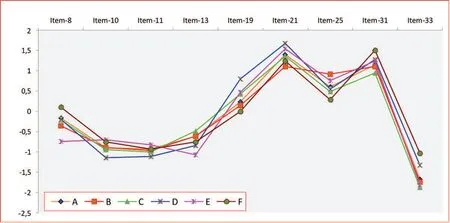
Fig.6 Person DIF plot based on the hometown of the respondents.A=Gorontalo,B=Gorontalo Regency,C=Bone Bolango Regency,D=Boalemo Regency,E=North Gorontalo Regency,F=Pohuwato Regency.
Figure 6 presents the graphics of nine items that have DIF based on respondents’ hometown. Here is the detail;1)respondents from Gorontalo cannot go with item 8(I am willing to pay extra free as long as renewable energy is used),and only a few of them who understand the effects of global warming(item 31);2)respondents from Gorontalo Regency do not take into account the danger of using renewable energy to the surrounding plants(item 25);3)respondents from Boalemo Regency find it difficult to agree with item 19(I do not know whether or not the use of renewable energy will cause environmental issues in the future)and item 21(I believe that the effects of global warming will be decreased by using the technology of renewable energy to produce power);4) respondents from North Gorontalo Regency strongly agree with item 8 and item 13 (the use of renewable energy is dangerous to surrounding animals),they also believe that global warming is now really occurring; 5)respondents from Pohuwato Regency find it very difficult to go with item 8 and tend to be not knowledgeable of the effects of global warming(item 31).
4 Discussion
The purpose of this study is to explore the prevalence of students’and teachers’ideas about renewable energy. It focuses on identifying the ideas generally comprehended by students and teachers,ensuring their knowledge as well as serving as the initial information regarding students’and teachers’knowledge of renewable energy. The main premise is that a strong idea about the advantages of renewable energy and its significance do influence one’s resistance,acceptance,or enthusiasm for the advantages of renewable energy(Kilinc¸ et al.,2009).
The first finding, regarding the advantages of using renewable energy, indicates that the safety factor is a priority; meanwhile,the willingness to pay an extra fee to utilize renewable energy is low. The second finding,related to the disadvantages of using renewable energy, shows that students and teachers assume that creating power generation technology from renewable energy sources is way more inexpensive;they also find it difficult to go with the idea that utilizing renewable energy is illogical and damages the environment. The third finding on the respondents’ viewpoint on the importance of utilizing renewable energy reveals that the respondents consider it more essential to use power generated from a safer technology of renewable energy generation, it does not endanger the surrounding people, and power consumption is available all the time; compared to the factors of the cost and safety of using renewable energy, the respondents more agree with the importance of utilizing renewable energy as mentioned previously. The last finding reveals that students and teachers strongly believe the occurrence of global warming present day;yet,they admit that they have limited knowledge of global warming effects.
All findings above describe various aspects of respondents’ contradictive understanding. For instance, a strong willingness to use the cheaper and safer technology of renewable energy. The respondents possibly do not understand that it requires a big investment of renewable energy technology to produce the all-time,safe, clean, and eco-friendly energy; this is what so called the misconception of the idea of renewable energy(Daniel et al., 2004). For this reason, respondents’ factual ideas are that power generation technology driven by renewable energy sources is way cheaper than other technologies. Consequently, most respondents do not consent to pay an extra fee for the use of renewable energy.
In addition, a large number of respondents believe that global warming is definitely occurring right now because there are lots of socialization about the effects of global warming. Unfortunately, this fact still has not taken their concern about the surrounding environment; they even rarely carry out activities that protect the environment. This tendency is unfavorable for the acceptance of the adoption of renewable energy technology in the future.
Other ideas that tend to be negatively understood are that the respondents do not know whether or not renewable energy will lead to serious environmental issues. In consequence, they believe that it is not safe to live around the technology of power generation driven from renewable energy sources;the cost for the shutdown is pretty expensive; this technology endangers the lives of animals,plants,and human. Human safety is placed at the last level compared to animals and plants. This indicates that students and teachers commonly get the use of renewable energy wrong.
From the aspect of gender differences,the prevalence of male and female respondents’ideas are significantly different. Male respondents opine that the use of renewable energy is safer, fulfills the needs of all people and plants. The female respondents, compared to male,tend to go with the thing that renewable energy will cause serious environmental issues in the future. Male respondents, on the other hand, are very concerned with the effects of global warming on the environment. This finding signifies that male respondents are more insightful than female respondents related to the utilization of renewable energy and global warming.
Based on the hometown differences, respondents from Gorontalo are objected to spending more money on power generation technology from renewable energy sources and do not know about the effects of global warming. This is understandable since this region commonly utilizes conventional power and the community has not yet experienced the effects of global warming,e.g.,extreme weather, excessive heat, unexpected disasters.For areas outside the city, it is figured out that the respondents are not familiar to the characteristics of the use of renewable energy.
5 Conclusion
This study has reported that the students’ and teachers’ ideas about the use of renewable energy tend to be contradictive;this reflects a relatively low understanding of this concept. Junior and senior high school students consider that utilizing renewable energy is not essential, yet they concern about the effects of global warming.Thus, their concern about the environment tends to be apprehensive. In contrast, teachers doubt the use of renewable energy technology in producing sustainable energy that is relatively not dangerous to the surrounding people and environment. These findings,overall, show that the students and teachers lack of knowledge of the utilization of renewable energy technology. Nevertheless,this study has limitations and implications in which it is only conducted to students and teachers in Gorontalo as one of the cities in Indonesia. It is believed that other provinces have a relatively different prevalence tendency due to the variety of culture and community habits. On that ground,Indonesia needs to develop a literacy education program of the use of renewable energy at various levels of formal education.
Acknowledgement
This research was partially funded by the Directorate of Research and Community Service of Directorate General of Research and Development Strengthening of Ministry of Research,Technology,and Higher Education of the Republic of Indonesia, and USAID through the SHERA program – Centre for Development of Sustainable Region(CDSR).In 2017-2019, CDSR is led by Centre for Energy Studies–Gadjah Mada University.
杂志排行
Journal of Environmental Accounting and Management的其它文章
- Do the Improved Water Sources for 203 Countries Converge over Time?
- Sustainability Evaluation of Sheep and Goat Rearing in Southern Italy. A Life Cycle Cost/Benefit Assessment
- Can Increase in the Share of Renewable Energy in Economic Growth Shift Turning Point of EKC?Evidence from Time-series Analysis in India
- Biochar as Improver of Methane Production in Anaerobic Digestion of Food Waste
- Green Economy as a Paradigm of Sustainable Development of the Republic of Kazakhstan
- An Integrated Pollution Prevention Ecosystem for Small-Scale Production of Raw Coco-nut Jelly in Craft Villages
——A Case Study from Mekong Delta,Vietnam
